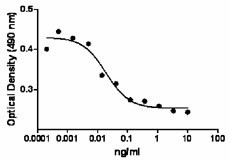- Regulatory Status
- RUO
- Other Names
- Tumor necrosis factor-α, Cachectin, Necrosin, Macrophage cytotoxic factor (MCF), Differentiation inducing factor (DIF), TNFSF2

-

Human TNF-α cytotoxicity on L929 cells.
| Cat # | Size | Price | Quantity Check Availability | ||
|---|---|---|---|---|---|
| 570102 | 10 µg | $147.00 | |||
| 570104 | 50 µg | $235.00 | |||
| 570106 | 100 µg | $422.00 | |||
| 570108 | 500 µg | $938.00 | |||
TNF-α is released from macrophages, monocytes, neutrophils, T-cells (principally CD4+), NK-cells and many transformed cell lines. Soluble homotrimeric TNF-α is released from cells by proteolysis of the integral membrane precursor form of TNF-α. TNF-α binding to some TNF-α receptors induces apoptosis and depending on cell type, receptor expression, and signal transduction status can induce other responses. TNF-α is involved in the inflammatory response.
Product Details
- Source
- Human TNF-α, amino acids Val77-Leu233 (Accession# NM_000594), was expressed in E. coli.
- Molecular Mass
- The 157 amino acid recombinant protein has a predicted molecular mass of 17,352 Da. The DTT-reduced protein and non-reduced protein migrate at approximately 16kDa by SDS-PAGE. The N-terminal amino acid is Val.
- Purity
- Purity is >98%, as determined by Coomassie stained SDS-PAGE.
- Formulation
- 0.22 µm filtered protein solution is in 10mM NaH2PO4, 150mM NaCl, pH 7.2.
- Endotoxin Level
- Endotoxin level is <0.1 EU/µg (<0.01ng/µg) protein as determined by the LAL method.
- Concentration
- 10 and 50 µg sizes are bottled at 200 µg/mL. 100 µg size and larger sizes are lot-specific and bottled at the concentration indicated on the vial. To obtain lot-specific concentration and expiration, please enter the lot number in our Certificate of Analysis online tool.
- Storage & Handling
- Unopened vial can be stored between 2°C and 8°C for up to 2 weeks, at -20°C for up to six months, or at -70°C or colder until the expiration date. For maximum results, quick spin vial prior to opening. The protein can be aliquoted and stored at -20°C or colder. Stock solutions can also be prepared at 50 - 100 µg/mL in appropriate sterile buffer, carrier protein such as 0.2 - 1% BSA or HSA can be added when preparing the stock solution. Aliquots can be stored between 2°C and 8°C for up to one week and stored at -20°C or colder for up to 3 months. Avoid repeated freeze/thaw cycles.
- Activity
-
The ED50 = 0.01 - 0.085 ng/mL as determined by the dose-dependent cytotoxicity of L929 cells stimulated with actinomycin D.
The specific activity of recombinant human TNF-α is approximately 5.35 x 104 IU/µg when compared against the 3rd WHO International Standard for Human TNF-α (NIBSC code: 12/154).
For more information on specific activity, please visit the Recombinant Protein Unit Conversions page. - Application
-
Bioassay
- Recommended Usage
-
Use when high specific biological activity is required.
- Application Notes
-
BioLegend carrier-free recombinant proteins provided in liquid format are shipped on blue-ice. Our comparison testing data indicates that when handled and stored as recommended, the liquid format has equal or better stability and shelf-life compared to commercially available lyophilized proteins after reconstitution. Our liquid proteins are verified in-house to maintain activity after shipping on blue ice and are backed by our 100% satisfaction guarantee. If you have any concerns, contact us at tech@biolegend.com.
-
Application References
(PubMed link indicates BioLegend citation) -
- Chen AR, et al. 1985. J. Immunol. 135:3978.
- Product Citations
-
Antigen Details
- Structure
- TNF superfamily; homotrimer
- Bioactivity
- Paracrine/endocrine mediator of inflammatory and immune functions; selectively cytotoxic for transformed cells; endothelial cell alterations; chemoattractant
- Cell Sources
- Activated monocytes, neutrophils, macrophages, T cells, B cells, NK cells, LAK cells
- Cell Targets
- Monocytes, neutrophils, macrophages, T cells, fibroblasts, endothelial cells, osteoclasts, adipocytes, astroglia, microglia
- Receptors
- TNFRSF1A (TNF-R1, CD120a, TNFR-p60 Type β, p55); TNFRSF1B (TNF-R2, CD120b, TNFR-p80 Type A, p75)
- Biology Area
- Cell Biology, Immunology, Innate Immunity, Neuroinflammation, Neuroscience
- Molecular Family
- Cytokines/Chemokines
- Antigen References
-
1. Fitzgerald K, et al. Eds. 2001. The Cytokine FactsBook. Academic Press San Diego.
2. Beutler B, et al. 1988. Annu. Rev. Biochem. 57:505.
3. Beutler B, et al. 1989. Annu. Rev. Immunol. 7:625.
4. Tracey K, et al. 1993. Crit. Care Med. 21:S415. - Regulation
- Type II integral membrane protein processed by TACE for secretion; upregulated by interferons, IL-2, GM-CSF, substance P, bradykinin, PAF, immune complexes, cyclooxygenase; downregulated by IL-6, TGF-β, vitamin D3, prostaglandin E2, PAF antagonists
- Gene ID
- 7124 View all products for this Gene ID
- UniProt
- View information about TNF-alpha on UniProt.org
